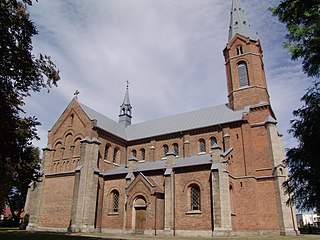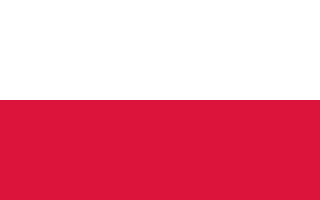Related Research Articles

The Polish Corridor, also known as the Danzig Corridor, Corridor to the Sea or Gdańsk Corridor, was a territory located in the region of Pomerelia, which provided the Second Republic of Poland (1920–1939) with access to the Baltic Sea, thus dividing the bulk of Germany from the province of East Prussia. At its narrowest point, the Polish territory was just 30 km wide. The Free City of Danzig, situated to the east of the corridor, was a semi-independent German speaking city-state forming part of neither Germany nor Poland, though united with the latter through an imposed union covering customs, mail, foreign policy, railways as well as defence.

The Polish złoty is the official currency and legal tender of Poland. It is subdivided into 100 grosz (gr). It is the most traded currency in Central and Eastern Europe and ranks 21st most-traded in the foreign exchange market.

Vegetation is an assemblage of plant species and the ground cover they provide. It is a general term, without specific reference to particular taxa, life forms, structure, spatial extent, or any other specific botanical or geographic characteristics. It is broader than the term flora which refers to species composition. Perhaps the closest synonym is plant community, but vegetation can, and often does, refer to a wider range of spatial scales than that term does, including scales as large as the global. Primeval redwood forests, coastal mangrove stands, sphagnum bogs, desert soil crusts, roadside weed patches, wheat fields, cultivated gardens and lawns; all are encompassed by the term vegetation.

Pomerelia, also known as Eastern Pomerania, Vistula Pomerania, and also before World War II as Polish Pomerania, is a historical sub-region of Pomerania on the southern shore of the Baltic Sea in northern Poland.

The Narew is a 499-kilometre (310 mi) river primarily in north-eastern Poland. It is a tributary of the river Vistula. The Narew is one of Europe's few braided rivers, the term relating to the twisted channels resembling braided hair. Around 57 kilometres (35 mi) of the river flows through western Belarus.

The Konik or Polish Konik is a Polish breed of pony. There are semi-feral populations in some regions. They are usually mouse dun or striped dun in color.

The Province of Posen was a province of the Kingdom of Prussia from 1848 to 1920. Posen was established in 1848 following the Greater Poland Uprising as a successor to the Grand Duchy of Posen, which in turn was annexed by Prussia in 1815 from Napoleon's Duchy of Warsaw. It became part of the German Empire in 1871. After World War I, Posen was briefly part of the Free State of Prussia within Weimar Germany, but was dissolved in 1920 when most of its territory was ceded to the Second Polish Republic by the Treaty of Versailles, and the remaining German territory was later re-organized into Posen-West Prussia in 1922.
Phytosociology, also known as phytocoenology or simply plant sociology, is the study of groups of species of plant that are usually found together. Phytosociology aims to empirically describe the vegetative environment of a given territory. A specific community of plants is considered a social unit, the product of definite conditions, present and past, and can exist only when such conditions are met. In phyto-sociology, such a unit is known as a phytocoenosis. A phytocoenosis is more commonly known as a plant community, and consists of the sum of all plants in a given area. It is a subset of a biocoenosis, which consists of all organisms in a given area. More strictly speaking, a phytocoenosis is a set of plants in area that are interacting with each other through competition or other ecological processes. Coenoses are not equivalent to ecosystems, which consist of organisms and the physical environment that they interact with. A phytocoensis has a distribution which can be mapped. Phytosociology has a system for describing and classifying these phytocoenoses in a hierarchy, known as syntaxonomy, and this system has a nomenclature. The science is most advanced in Europe, Africa and Asia.
S11 may refer to:
S19 may refer to:

The Żarnowiec Nuclear Power Plant was to be the first nuclear power plant in Poland. The construction was cancelled due to changes in the economic and political situation in Poland, in the Soviet Union and in the Eastern Bloc and due to the Chernobyl disaster in 1986 and the following years. It was to be located in the former village of Kartoszyno and had its seat in Nadole.

Połaniec is a town in Staszów County, Świętokrzyskie Voivodeship, Poland, with 8,406 inhabitants (2012). The town is in Lesser Poland, and its history dates back to the early days of Polish statehood. It lies in the western part of the Sandomierz Basin, a few kilometres north of the Vistula, along the National Road Nr. 79, from Bytom to Warsaw. The town has a railway station serving a secondary line, nr. 75 from Rytwiany to Połaniec.

The Poland national under-21 football team is the national under-21 football team of Poland and is controlled by the Polish Football Association.

Deschampsia flexuosa, commonly known as wavy hair-grass, is a species of bunchgrass in the grass family widely distributed in Eurasia, Africa, South America, and North America.
Dr Martin Lewis Page is an English botanist, ecologist and plant photographer.
British NVC community OV17 is one of the open habitat communities in the British National Vegetation Classification system. Although classed with communities OV15 and OV16 as an arable weed community of light lime-rich soils, it also shares many features with the communities classed as arable weed and wasteland communities of fertile loams and clays.
British NVC community OV38 is one of the open habitat communities in the British National Vegetation Classification system. It is one of six communities of crevice, scree and spoil vegetation.

Cecilia is a section of the Table Mountain National Park on the lower eastern slopes of Table Mountain in Cape Town, located just to the south of Kirstenbosch National Botanical Garden. It was previously used for commercial logging and known as Cecilia Forest or Cecilia Plantation, but has now been given protected status and integrated into the National Park.
Polish Rugby Union, abbreviated to PZR, is the only legal Polish representative of Polish rugby union and rugby sevens for both men and women's rugby and all age groups.
References
- Notes
- ↑ Faber-Langendoen, Don; Keeler-Wolf, Todd; Meidinger, Del; Tart, Dave; Hoagland, Bruce; Josse, Carmen; Navarro, Gonzalo; Ponomarenko, Serguei; Saucier, Jean-Pierre; Weakley, Alan; Comer, Patrick (2014). "EcoVeg: a new approach to vegetation description and classification". Ecological Monographs. 84 (4): 533–561. doi:10.1890/13-2334.1. ISSN 0012-9615.
- ↑ Benson, J.S. (2006). "New South Wales Vegetation Classification and Assessment: Introduction — the classification, database, assessment of protected areas and threat status of plant communities" (PDF). Cunninghamia. 9 (3): 331–382. Archived from the original (PDF) on 2015-09-24. Retrieved 2016-09-24.
- ↑ Harris, S.; Kitchener, A. (2015). From Forest to Fjaeldmark: descriptions of Tasmania's vegetation (2nd ed.). Hobart: Department of Primary Industries, Parks, Water and Environment. ISBN 978-0724667970 . Retrieved 6 June 2016.
- ↑ Based on Mucina et al. 1993, Die Pflanzengesellschaften Österreichs, Vol 1; Grabherr & Mucina 1993, Die Pflanzengesellschaften Österreichs, Vol. 2; Willner & Grabherr 2007, Die Wälder und Gebüsche Österreichs
- ↑ Austrian Vegetation Database
- ↑ De Vlaamse vegetatiedatabank Archived 2011-10-05 at the Wayback Machine
- ↑ "IBGE | Portal do IBGE | IBGE".
- ↑ CNVC
- ↑ Principles of the classification, accessed 26 August 2011
- ↑ National Phytosociological Database
- ↑ Danske Vegetationstyper
- ↑ SynBioSys Europe, accessed 25 August 2011
- ↑ Sophy
- ↑ FloraWeb - Daten und Informationen zu Wildpflanzen und zur Vegetation Deutschlands, accessed 25 August 2011
- ↑ VegetWeb
- ↑ English summary of Vegetweb, accessed 25 August 2011
- ↑ "Home - Vegetation Databases Halle - German Vegetation Reference Database (GVRD)".
- ↑ National Vegetation Classification
- ↑ National Vegetation Database
- ↑ National Vegetation Database
- ↑ Singers, Nicholas J.D.; Rogers, Geoffrey M. (2014). A classification of New Zealand's terrestrial ecosystems (PDF). Wellington: Department of Conservation. ISBN 9780478150131.
- ↑ Regionalizacja geobotaniczna Polski (in Polish)
- ↑ Potencjalna roślinność naturalna Polski (in Polish)
- ↑ Polska Baza Danych o Roślinności (in Polish)
- ↑ System Wymiany Informacji o Bioróżnorodnosci - bazy danych (in English)
- ↑ Monitoring gatunków i siedlisk przyrodniczych (in Polish)
- ↑ Bank Danych o Lasach - mapa interaktywna (in Polish)
- ↑ Przewodnik do oznaczania zbiorowisk roślinnych Polski (in Polish)
- ↑ CDF
- ↑ National Vegetation Classification Standard (Version 2.0), February 2008, accessed 25 August 2011
- ↑ USNVC
- ↑ Vegbank page the Ecological Society of America